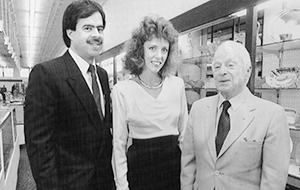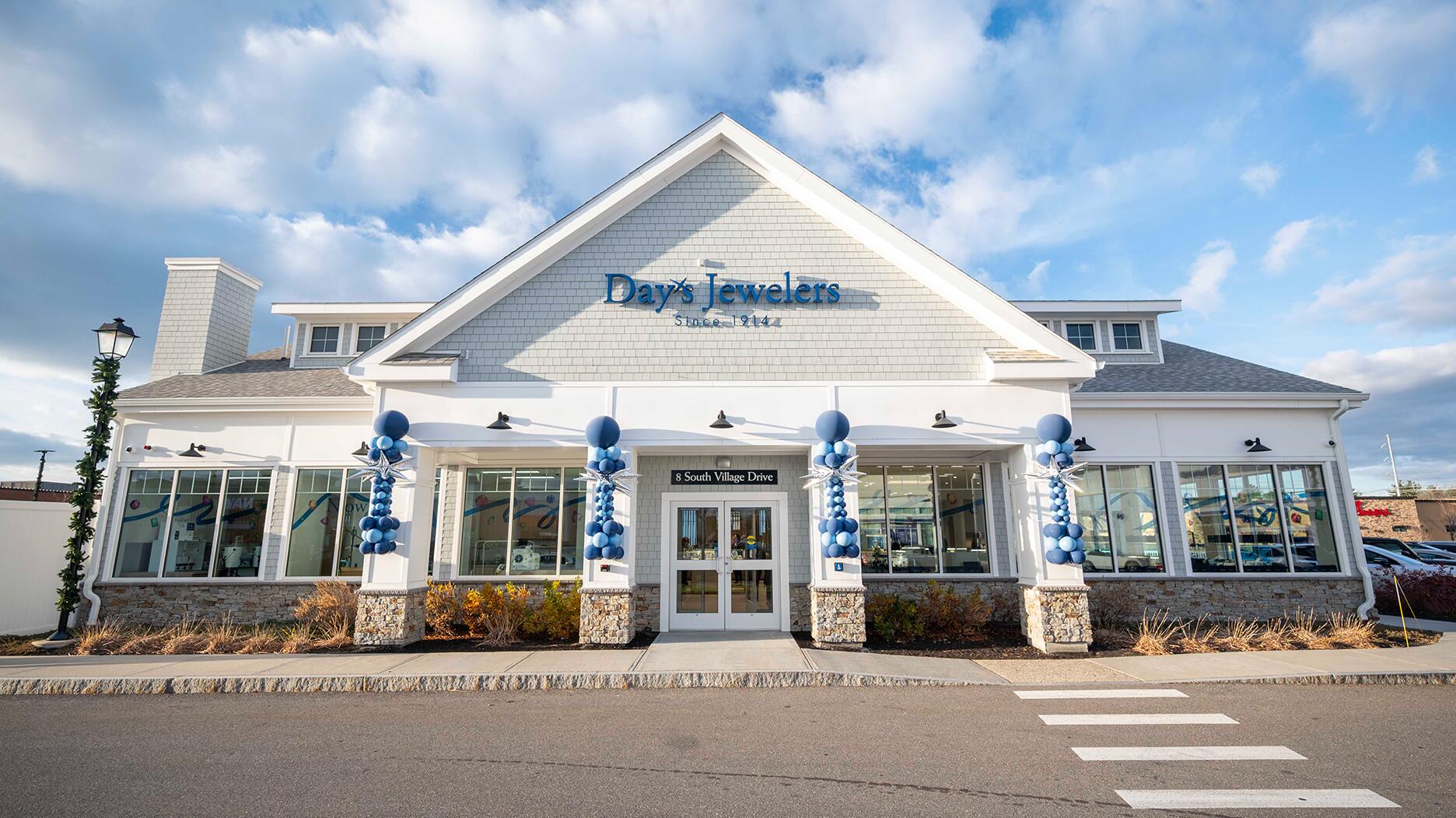The special-edition egg pendant ingested in a New Zealand jewelry store was recovered after a six-day wait.
About Retail: Surviving a Century
A 100th anniversary is not a milestone many retailers reach, making it certainly something worth celebrating. National Jeweler recently talked to three jewelers who will mark a century in business this year to learn more about the keys to success and what they’re doing to keep going.

National Jeweler recently spoke with three jewelers whose stores are marking 100 (or more) years in business in 2014 to get an idea of how they made it through a century and what they would tell other jewelers looking to do the same.
Creating a community
Rather than referring to a store or a number of stores, Jeff Corey of Day’s Jewelers talks about it as an “organization,” with a unifying set of core values that work to build a company “that stands the test of time.”
Day’s was originally founded in 1914 as a small pawn shop in Portland, Maine by Captain Harry Davidson, who had to leave life at sea due to illness. He was joined in time by his three sons, and over the years the family established 21 stores across New England.
In 1988, the remaining owners of Day’s, Sidney and David Davidson, decided to sell the business, to current owners Jeff, Jim, and Kathy Corey, and Mark Ford. Jeff and Jim’s father had worked for the Davidsons before, and had taught his children the Day’s culture and values.
The ideals that the company teaches to employees include providing everyone with the opportunity to own fine jewelry through a range of products and price ranges, providing the best value in both goods and services, and viewing customers’ jewelry beyond just monetary value, taking into account sentimental value, Corey says.
To ensure a lasting future, the company is also adapting to the world of technology, including a focus on its website, which features thousands of items and is updated regularly to remove those that are no longer available.
Day’s is also creating a company environment that gives a voice to all its employees.
“We’re a company that trusts people,” Corey says. “Our employees are given the authority to make their own decisions across the company. If we’re going to be successful, we need to find a way to tap into the mind of every individual in our company, and that’s not always an easy task. Mistakes are made, and we use that as part of the learning process.”
Building on the past
Samuel Gordon Jewelers in Oklahoma City, Okla. took a chance in 1990 when it consolidated its three existing locations into one 12,000-square-foot “superstore,” as CEO Gary Gordon refers to it.
Founded in 1904 and celebrating 110 years in business this year, the jeweler is now under control of the third generation of Gordons.
“Throughout all of it, the reason we’re still going is that we’ve always had great watches to sell,” Gordon says. “There wouldn’t be a store today without watches. The bridal department is physically the largest in our store now and we’ve built a background in diamonds and engagement rings, and the watch department is not quite as important as it used to be, but it more than made up for it in the past.”
With all the personal technology that many consumers may use to keep track of time these days, watches have “take on another life,” Gordon says, noting that many of the people he sells to now are wearing them to express their style or make a fashion statement.
The company developed a plan some 10 years ago to promote more aggressively, including advertising at bridal events.
Gordon notes that they also focus on a “healthy mix” of advertising and promotions on their social media accounts, including Facebook and Twitter, as well as classic advertising in the newspaper, on billboards and on television.
“We’ve enjoyed modest growth every year since the recession,” Gordon says. “We are very careful and mindful of having the right lines for our customers. We have highly trained sales people and we try to keep everybody fresh on industry news.”
When looking back at his experience and what he’s learned, Gordon says, “My advice to any retailer is this: Take care of your customers, your employees, your vendors and yourself, and everything else will pretty much fall into place.”
All in the family
Newton’s Jewelers in Fort Smith, Ark., has seen three generations of the Newton family at the helm, and is still managed by the same set of core values with which it was started.
Founded by George Newton in 1914, the store continued on through Bill Newton and Kelly Newton, who currently runs it.
“We always maintained high quality and honesty,” Newton says. “My grandfather was a stickler for telling the truth, and it stuck. That’s how he made everyone run the business.”
Newton adds that one of the major changes the store has seen over time is that they depend more on the volume of sales rather than on pieces generating higher profit these days.
Just as is the case with Samuel Gordon Jewelers, the engagement ring business is a large part of the store’s business. Newton adds that Rolex watches have been extremely important for the company throughout its history and remain strong sellers.
Newton’s Jewelers has begun putting more emphasis on social media. While they still do traditional ads, they’ve trimmed the budget in that area and it’s had little effect on sales, according to Newton.
The advent of technology and the new platforms that are available to jewelers has made the industry vastly different from what it was when the store was founded. But by embracing the changes the company has been able to navigate the years successfully.
The Latest

Associate Editor Natalie Francisco plays favorites with Piece of the Week, selecting a standout piece of jewelry from each month of 2025.

The “Love and Desire” campaign is inspired by the magic that follows when one’s heart leads the way, said the brand.

How Jewelers of America’s 20 Under 40 are leading to ensure a brighter future for the jewelry industry.

Two awardees will receive free tuition for an educational course at the Swiss lab, with flights and lodging included.


Berta de Pablos-Barbier will replace Alexander Lacik at the start of January, two months earlier than expected.

Sotheby’s held its first two jewelry sales at the Breuer building last week, and they totaled nearly $44 million.

Roseco’s 704-page catalog showcases new lab-grown diamonds, findings, tools & more—available in print or interactive digital editions.

Winners will receive free registration and lodging for its fourth annual event in Detroit.

Here are six ideas for making more engaging content for Instagram Reels and TikTok, courtesy of Duvall O’Steen and Jen Cullen Williams.

The honorees include a notable jewelry brand, an industry veteran, and an independent retailer.

Carlos Jose Hernandez and Joshua Zuazo were sentenced to life without the possibility of parole in the 2024 murder of Hussein “Sam” Murray.

Yood will serve alongside Eduard Stefanescu, the sustainability manager for C.Hafner, a precious metals refiner in Germany.

Set in a Tiffany & Co. necklace, it sold for $4.2 million, the highest price and price per carat paid for a Paraíba tourmaline at auction.

The jeweler’s “Deep Freeze” display showcases its iconic jewelry designs frozen in a vintage icebox.

Take luxury gifting to new heights this holiday season with the jeweler’s showstopping 12-carat sphene ring.

This year's theme is “Unveiling the Depths of the Ocean.”

In its annual report, Pinterest noted an increase in searches for brooches, heirloom jewelry, and ‘80s luxury.

Starting Jan. 1, customers can request the service for opal, peridot, and demantoid garnet.

The new catalog features its most popular chains as well as new styles.

The filmmaker’s personal F.P. Journe “FFC” prototype was the star of Phillips’ recent record-setting watch auction in New York.

The new location in the Design District pays homage to Miami’s Art Deco heritage and its connection to the ocean.

Inflations, tariffs, and politics—including the government shutdown—were among consumers’ top concerns last month.

“Longtime favorite” presenters, as well as first-time speakers, will lead talks and workshops at the annual event in Tucson next year.

Silas Smith of Meridian Metalworks won the challenge with his pendant that blends Australian and American landscapes.

The sale of the 31.68-carat, sunset-hued stone was part of Sotheby’s first series of events and auctions in Abu Dhabi.

Most customers who walk into your store this month have made up their minds. Your job is to validate their choice, Emmanuel Raheb writes.



























